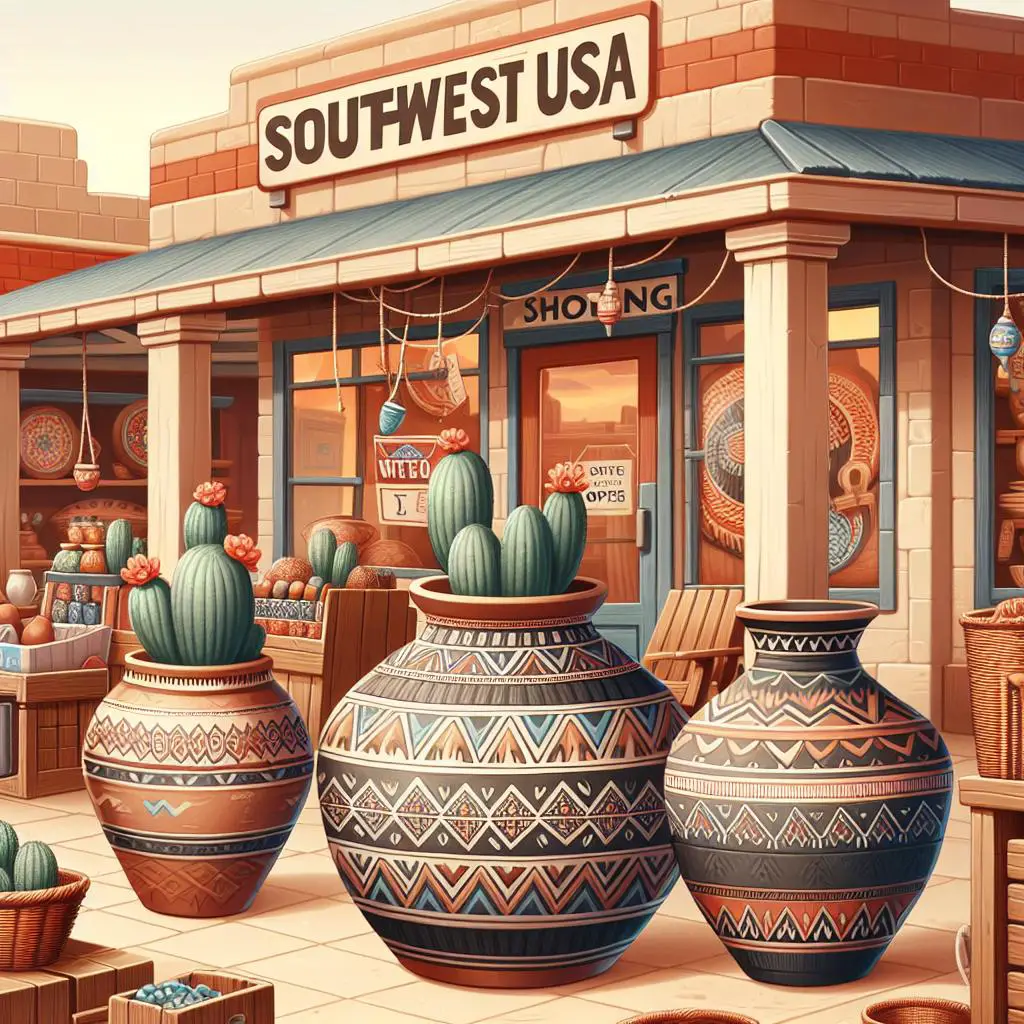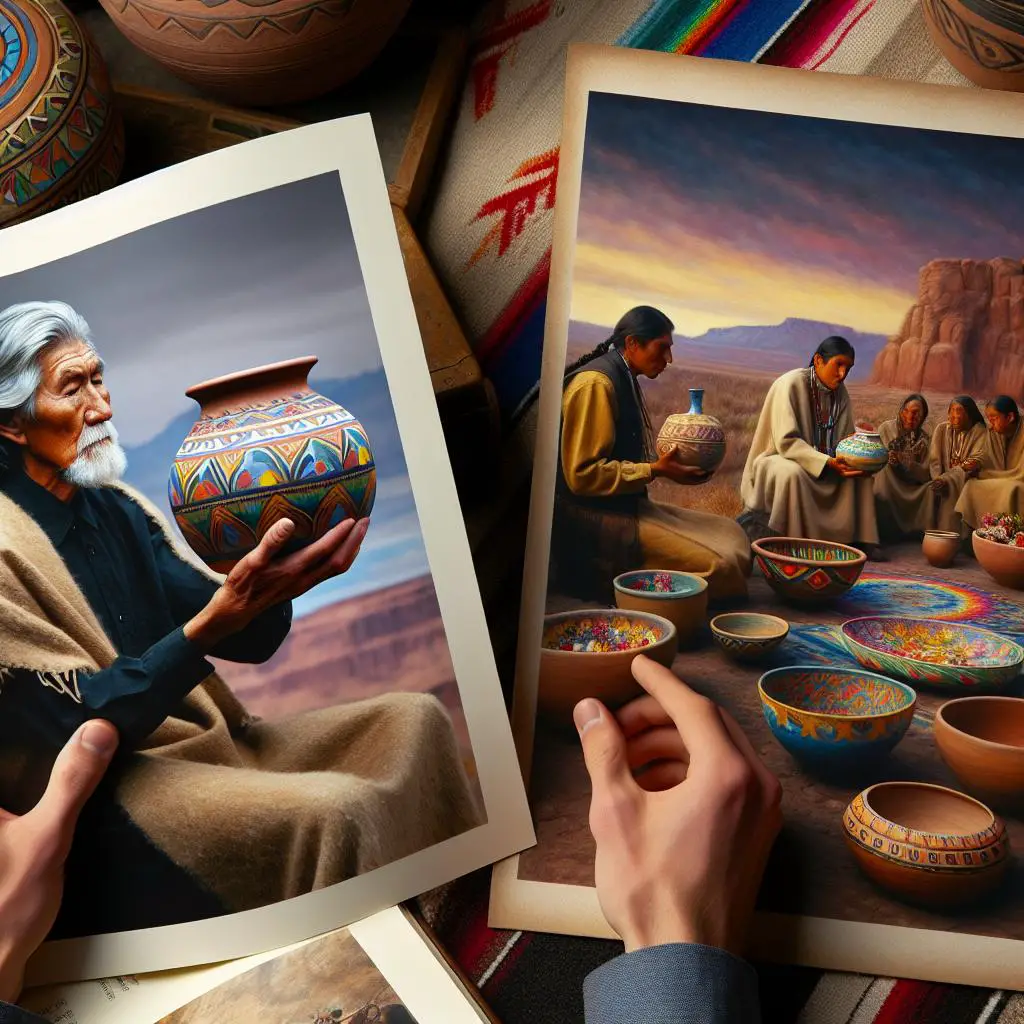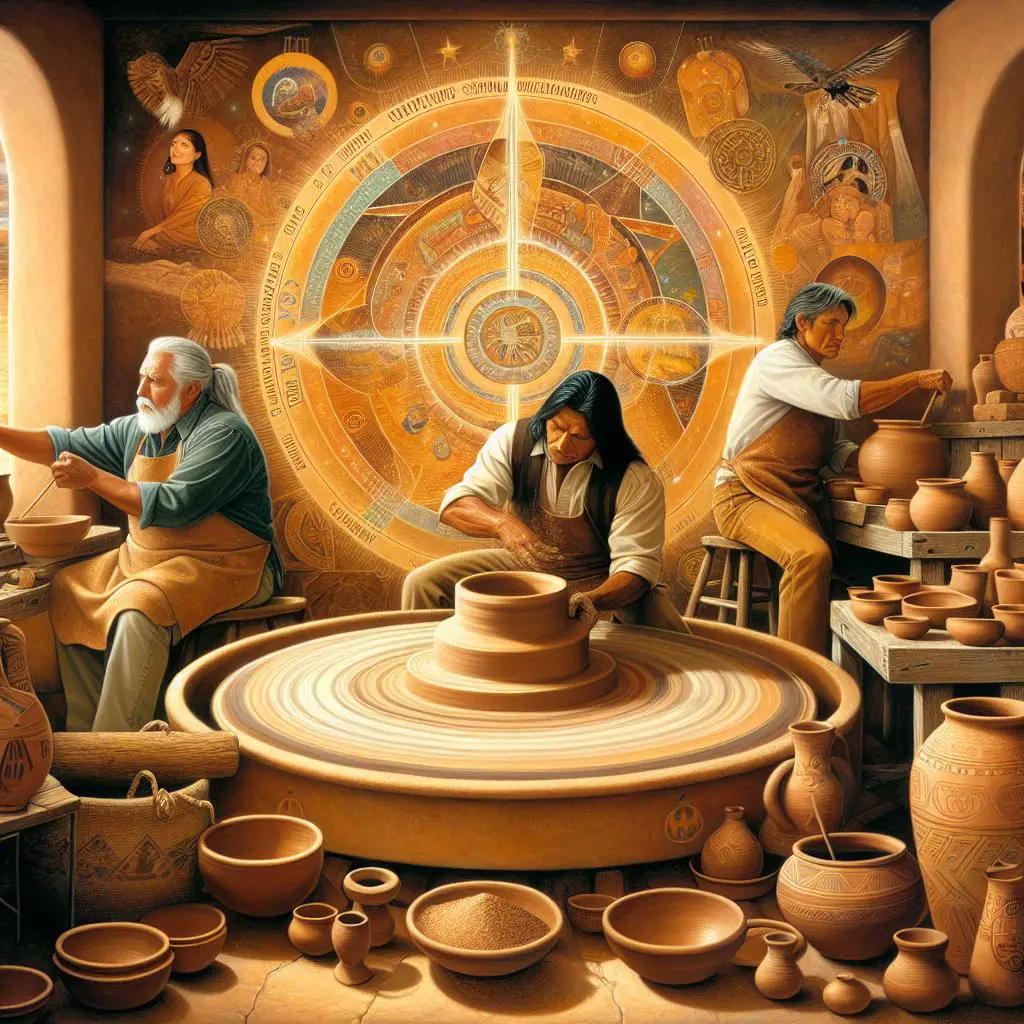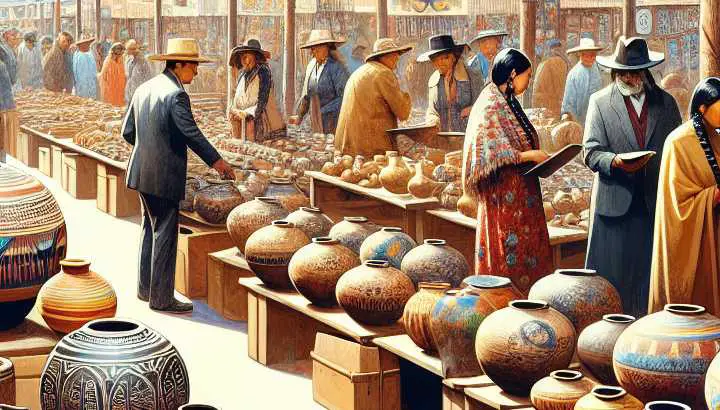The Spiritual Significance of Native Pottery

1. Symbolism and beliefs expressed through Native pottery
Title: The Clay Tale: Native Pottery and the Symbols That Dance on Them
Allow us to dive into the world of native pottery, an ancient realm where mud isn’t just mud and pots aren’t merely for cooking your beans. In this fascinating world, a lump of clay holds magical potential, waiting to be shaped with hands guided by ancestral spirits and tradition. The Native American pottery scene? More like a pottery rave! Clay is the unsung hero, patterns are the DJ, and every pot, bowl, or vase is a chance to express a thousand years of culture and belief.
Forget about your high school ceramics class; this is Native American pottery, friend. We’re not aiming to make an ashtray for Uncle Bob. No siree! We are dealing with art forms where every minute detail, each curve, line, and imprint unveils an entire narrative in clay.
One of the most delightful aspects of Native American pottery is its rich symbolism. It’s a piping hot bowl of metaphor soup. This isn’t just about slinging mud around; each design, pattern, and color has a deeper meeting – like secret messages inscribed on the surface, often interpreting tribal beliefs, traditions and the artist’s personal story.
Eagle feathers, spirals, rain clouds, snakes… they aren’t just cool aesthetics. These are symbolic elements bearing a deeper message about life, nature and spirituality. An eagle feather, for instance, is considered a gift from the Creator himself that embodies the power and balance between earth and sky. Spirals can symbolize the journey of life and death, while the lightning symbol often stands for speed, power, and the mystic forces of nature.
Getting the hang of this? All the while you thought the handprint was just a primitive form of calling dibs, but sorry to burst your bubble, it’s the symbol of human life!
What about the clay’s color, you ask? Well, prepared to be wowed.
“It will hardly do to divide the nation into intelligent Protestants and illiterate Catholics: the point is that the somewhat crude symbolism which had satisfied the cravings of the average man had ceased to be sufficient for his newer intelligent needs; he demanded either a higher symbolism or else as little as possible”
~ A. F. Pollard , The History of England
The clay color might represent a specific tribe or geographic area. For example, the Acoma Pueblo pottery, also called ‘sky city’ pottery, is known for its white background as pure as the cumulus cloud (yes, that’s the fluffy one). Meanwhile, the Hopi tribe, on the other hand, pretty much nails earthy hues with yellow and red clay. They make an iconic vessel – the wedding vase – which is a clay cupid firing symbolic arrows of matrimonial unity.
And just when you thought we’ve hit the pottery ceiling, there’s more! The cooking method also injects symbolism. Many Southwestern tribes believe smoke from the firing cement the pottery’s connection with life force elements – earth, water, fire, and air. This is not just your regular barbecue, folks!
Let it be known that the beauty of these pots, plates and vessels doesn’t stop at their astounding aesthetic. They are timeless narrators of indigenous culture, each design a verse, each symbol a story and each vessel an epic.
From the cosmic spirals to the earthly clay colors, the symbolism and beliefs expressed through Native pottery create this one-of-a-kind masterpiece, a literal history written in mud. Moreover, deciphering these containers’ codes gives us not only an insight into the diverse facets of Native American culture but a whole new perspective to appreciate art and belief.
But remember, while the symbolism can easily whisk us into a profound philosophical journey to rooted ancestry and sacred beliefs don’t forget the simplicity that these are cucumbers rescued from becoming pickles or hand-me-down bean storages parading supreme aesthetics, and narrating a tale as old as time. So next time you see Native pottery, don’t just awe at them, read them!
Learn More Here: 1. Symbolism And Beliefs Expressed Through Native Pottery

2. Ritualistic uses of Native pottery in ceremonies
Tile by tile, wheel-spun and sun-baked, the story elegantly unfolds. A clay chameleon of sorts, alchemically morph-transfigured under the watchful eyes of time and tradition, Native American pottery is known for its rich history, functional beauty, and intriguing symbolism. Quite honestly, it puts your ‘Made in China’ fine bone china to shame. As it turns out, Native American pottery is more than just eye-candy that adorns the mantelpiece; it’s the material manifestation of stories, spirit, and numerous ritualistic uses.
At the crack of dawn, just when the rooster stretches his vocal cords, a Pueblo woman would take a pot resplendent with geometric designs as intricate as a spider’s web, and fill it with corn. Not for a substantial breakfast to pad out that Wonder Woman physique, no-no-no. Instead, this maize-filled masterpiece had a ceremonial role, symbolizing bountiful harvest in Pueblo corn-powdered ceremonies. Picture an ancestral knuckle-rapping on the underside of a pot, a syncopated heartbeat accompanying songs beseeching the gods for rain and fertility.
If you’re a hop-head forever questing for the perfect brew, bear with me. The Ale-chemist of the Hopi tribe would give you a stiff competition in a brewing contest. Their pottery, crafted with diligent hands like Mozart playing the piano, wasn’t made for a boutique IPA, but for a fermented corn nectar called ‘Tiswin’ used in the feisty Niman festival. Reinforcing the adage that a little beer can bring people together, the Tiswin, lovingly held in a sacred pot, was given a VIP seat at social gatherings and rituals. Can your pint do that?
Then we have the Navajo tribe, clad in their psychedelic tie-dye, bringing their own brand of pottery to the party.
“There is better evidence for the so early existence of Miletus, where the German excavators have found much pottery of the latest Aegean age, than of any other”
~ D. G. Hogarh, The Ancient East
Instead of using these handicrafts as mere functional vessels – oh, the outrage! – they employed them for sacred rituals like the Night Chant, a nine-night healing ceremony longer than your average Netflix series binge-session. Here, sand-painted pots unveiled a prescription of healing. Every line and curve on the pottery echoed songs, dances, and prayers for health, balance, and restoration. Thus, the pottery was more than just a piece of art; it was a testament to their enduring faith.
In the gloaming, when the day meets the night in a harmonious palette of colors, stunning black-on-black pottery of the San Ildefonso Pueblo would take the center stage. This wasn’t a Black Friday deal, but a ceramic dance of life. Fired under a cover of cow manure – hold your noses, darlings – the pottery emerged beautifully shadowed and robust. This pottery was a toast to the circularity of life in San Ildefonso rituals, encapsulating stories of creation and evolution with the grace of a prima ballerina.
Despite veils of time sweeping across sand-dusted terrains, Navajo, Hopi, Pueblo, and San Ildefonso tribes have preserved their ceramic symphony, not on Spotify, but in their rituals passed down from generation to generation. They’re not mother-in-law approved chintzy knick-knacks or even a dandy centerpiece for a manicured minimalist living room. Each shard of clay, each thumbprint dent is a peep into the time-machine of Native American traditions, their prayers, their myths, and their incredible persistence to keep their culture alive, one beautiful pot at a time.
So, next time when someone gets awed looking at your store-bought, polyester plant pot and asks, “Is that a Native American pot?” take pride in correcting them with an informed, “Well, I’m afraid it won’t conduct rain dances, nor does it jive with sacred corn beer. But it holds my petunias rather nicely.”
Source: 2. Ritualistic Uses Of Native Pottery In Ceremonies

3. Connection between pottery creation and spiritual practices
Clay—a murky hodgepodge of silica, alumina, water, and a few mystery odds and ends—isn’t the first thing that comes to mind when one thinks of spiritual practice. But pottery and spirituality go together like spaghetti and meatballs or like Netflix and cold, lonely nights. There’s an enchanting, almost magical connection between forming a lump of clay with your hands into something beautiful, functional, or both, and various spiritual traditions from around the world.
So, sit comfortably, grab a snack (or better yet, some clay) and let’s embark on a cherished journey down the pottery lane, revealing the spiritual essence of this craft. Credit to your yoga pants if you’re wearing them already – we’re about to get Zen with ceramics!
First off, let’s talk about the process. When you’re crafting pottery, your hands are deeply immersed in the clay, shaping its destiny, guiding its transition from a blob of nothing much to something worth Instagramming (#nofilterneeded). Likewise in spirituality, we’re constantly molding our lives and twisting our souls into better, more enlightened versions of ourselves. Consider your soul an ethereal clod yearning to be morphed into a cosmic vase. Too esoteric? Alright, let’s dial-down the spiritual lingo and get real; who among us hasn’t attempted a drastic life change after a few cups of herbal tea and an empowering horoscope read?
Moving on, let’s delve into the mysterious and ancient world of Japanese pottery, where Zen Buddhism heavily influences the craft. The concept of “wabi-sabi,” embracing imperfection and transience, is a major principle. In this artistry, a teacup with a slight crack or an unbalanced vase is not tossed aside or ended up in a garage sale, but cherished for its uniqueness. It’s as if the pottery is whispering, “Hey, it’s okay to be a touch messed up.
“Indeed she was well-nigh matchless as a creation of nature and polite society”
~ Philip
Verrill Mighels, When a witch is young
We all are!” And if that doesn’t connect to spiritual practices and less-than-perfect human lives, I don’t know what does.
Now, let’s take a deep dive into the glowing heart of the potter’s wheel, metaphorically speaking. Consider the spinning wheel as a physical representation of the wheel of life, the ups, the downs, the smooth spinning, the wobbly off-balance moments, the hunky pottery teacher ghosting you (we all watched “Ghost,” right?). It’s meditative, soothing, and perhaps a touch dizzying – just like life, meditation, and the last ten minutes of a strong yoga class.
Lastly, the process of firing—the act of subjecting the clay piece to insane temperatures until it hardens like your resolve not to cry at Pixar movies—is strikingly similar to spiritual purification. Through trials and tribulations, we mature, develop resilience, and become stronger, just like our clay counterpart. Plus, like us after a good spa day, the pottery looks 100% more fabulous after firing!
In conclusion, pottery creation and spiritual practices have an undeniable connection. By intertwining humility, acceptance of flaws, the wheel of life, and not forgetting the graceful transformation under pressure, pottery becomes not just an art but a spiritual encounter. So, the next time you find yourself up to your elbows in clay, remember: you’re not just making an incredibly heavy coffee mug; you’re interacting with the spiritual symphony of the universe. No pressure then!
So, release your inner Ghost-movie-Patrick-Swayze (or Demi Moore, depending on preferences) and let spirituality spin your clay of life to an impressive piece of art. Laugh at the wobbles, embrace the cracks and appreciate the beauty that emerges from the fire. Happy potting!
Enjoyed This? Here’s More: 3. Connection Between Pottery Creation And Spiritual Practices
